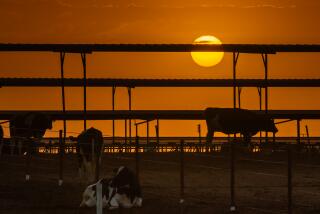Mad Cow Case Is 1st Born in U.S. to Have Disease
- Share via
WASHINGTON — The U.S. Department of Agriculture said Wednesday that the second confirmed case of mad cow disease in the United States was in a 12-year-old animal that had spent its entire life in Texas.
It was the first cow born in this country to test positive for the brain-wasting disease.
The cow apparently lived on one ranch until being shipped for slaughter to a pet food factory in Waco, said John Clifford, the USDA’s chief veterinarian.
Officials have quarantined the other animals in the diseased cow’s herd, said Bob Hillman, executive director of the Texas Animal Health Commission.
The age of the recently identified cow was a relief to the USDA: Clifford said the cow was probably infected by eating cattle feed made of ruminant meat and bones, which the U.S. banned in 1997.
Steve Sundlof, director of the U.S. Food and Drug Administration’s Center for Veterinary Medicine, said the USDA would examine records of the animal’s feed to investigate how it became infected. Feed mills have recorded compliance with federal standards established in 1997 in response to concerns about mad cow disease.
Sundlof also said the USDA would try to find and test herd-mates born within a year of the diseased cow, as well as the cow’s recent offspring.
However, the cow’s age means its siblings could have been slaughtered before 1997, when the department ordered slaughterhouses to keep careful records on the disposition of all meat. (Many beef cows are slaughtered before they are 4 years old.)
Clifford said the case demonstrated that “our interlocking safeguards are effective.”
But the president of the Humane Society of the United States, Wayne Pacelle, said that “if this animal became sick from the feeding practice, presumably the same practices could have been infectious for many other animals.”
The U.S. announced its second case of mad cow, or bovine spongiform encephalopathy, on Friday, saying that DNA tests would be used to confirm its origin. Taiwan announced the next day that it would reimpose its ban on U.S. beef.
The previous U.S. case of mad cow disease -- discovered in December 2003, in a cow imported to Washington state from Canada -- sent U.S. beef exports tumbling about $2.5 billion. Japan, the largest importer of U.S. beef at the time, promptly banned U.S. beef imports.
The existence of mad cow disease in a U.S.-born cow could renew the dispute between the U.S. and Canadian beef industries. The United States blocked the import of Canadian cows in May 2003 after Canada identified a case of mad cow disease in Alberta, and the Canadian Cattlemen’s Assn. is seeking to reopen the border.
“This supports our position,” said Canadian Cattlemen’s Assn. spokeswoman Cindy McCreath. “Risk factors are identical on both sides of the border.”
The disease can be transmitted from cattle to humans as variant Creutzfeldt-Jakob disease, which has no cure. An outbreak of the disease in Europe in the 1990s is thought to have claimed about 150 lives, mostly in the United Kingdom.
More to Read
Sign up for Essential California
The most important California stories and recommendations in your inbox every morning.
You may occasionally receive promotional content from the Los Angeles Times.













